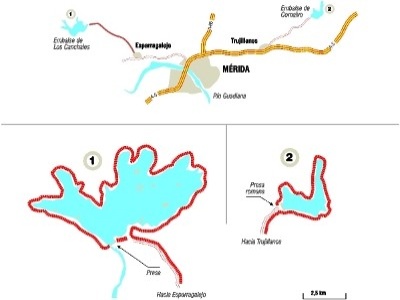Cornalvo Reservoir
Travellers
del Cornalvo Reservoir
Location and access
This route is at the heart of Cornalvo Natural Park, which is situated between the Vegas del Guadiana and the spurs of the Sierras de San Pedro and Montánchez. It goes through the municipal areas of Mérida and Trujillanos (Badajoz).
It’s best to access the route from the “Autovía de Extremadura” (A-5), continuing along it until you reach the town of Trujillanos, taking exit 334 (towards Madrid) or 325 (towards Mérida). Before you enter Trujillanos you will find a roundabout, where you should take the first exit, to the right, which will take you straight to Cornalvo Reservoir.
Description of the route
This birdwatching route starts from the Centre of Interpretation of Cornalvo Natural Park, which we strongly recommend you to visit and where you can get more information about this protected area and other possible routes. About 7 km from the Centre of Interpretation you will find a turning on the right that will take you to the Dam of Cornalvo Reservoir. If you have come this far by car you must park here before you get to the dam and continue on foot. The route goes around the reservoir, always following the paths. Start by crossing the wall of the dam, and then continue along a path that takes you first through a thick cork oak grove and then through more open areas with views of the reservoir. You will reach the end of the reservoir after about 2800 m, at which point you will have done almost half the route and will start going back towards the starting point. From the end to the wall of the dam the route goes along a path that is in a good state and which keeps parallel to the reservoir. The whole route round the reservoir is 6800 m long; although when the water level is low you can take different routes, shortening the distance, particularly in the end section.
Ornithological interests
Cornalvo Natural Park was one of the first areas to be declared a Special Protection Area for birds (SPA) in Extremadura, called “Embalse de Cornalvo y Sierra Bermeja”.
The predominant habitats between the Centre of Interpretation and Cornalvo Reservoir are rain-fed cereal fields, olive groves and open dehesa of Holm oak groves. 2.3 km from the start you will reach a bridge over the River Albarregas, where there is a dense wooded area and it’s worth stopping here to watch birds. Large pools of water usually remain in summer attracting numerous species to drink (warblers, tits, finches, larks). In the cereal fields and pastures that extend from the bridge to Cortijo de Campomanes it’s possible to see Montagu’s Harrier, Black-winged Kite, Little Owl, Stone Curlew, Little Bustard, Southern Grey Shrike, Zitting Cisticola and Thekla Lark.
It’s good to have a telescope with you when you reach the dam as the water birds are normally in the middle of the reservoir. The most frequent species are Mallard, Northern Shoveler, Common Teal, Gadwall, Pintail, Eurasian Wigeon, Common Coot, Grey Heron, Little Egret, Great Crested Grebe, Little Grebe, Great Cormorant, Lesser Black-backed Gull, Black-headed Gull and Little Ringed Plover. If you are lucky you can see Black Stork feeding on the banks, one of the emblematic birds of this protected area. In the shallower areas (such as the islands, islets and the shoreline) you can see several species of waders, the diversity of which is much greater during the autumn passage (from July to October), and which include Black-winged Stilt, Common Redshank, Dunlin, Curlew Sandpiper and Little Ringed Plover.
A path begins at the end of the dam that goes up into a thick cork oak grove where you can see typical forest species such as European Nuthatch, Short-toed Treecreeper, Nightingale, Wren, Common Chaffinch, Eurasian Bullfinch, Hawfinch, Blue, Crested and Great Tits, Blackbird, Common Wood Pigeon, Eurasian Jay, and Great and Lesser Spotted Woodpeckers. In the areas predominated by bushes (mostly rock rose patches and moorland) it’s easy to find species typical of this type of vegetation, such as Sardinian and Dartford Warblers and Dunnock (the latter only in winter).
Once the path leaves the slope the density of Holm and cork oaks lessens, with dehesa areas appearing that alternate with scrubland and pastures, and it’s easier to see the birds. Spotted Flycatcher, Azure-winged Magpie, Hoopoe, Woodlark and Woodchat Shrike occur in the dehesa areas. With more open visibility it’s easier to see breeding birds of prey (Booted Eagle, Common Buzzard, Short-toed Eagle, Black Kite) and other species that search for food in the dehesa such as Griffon Vulture, Eurasian Black Vulture and even Spanish Imperial Eagle.
Best time to visit
The route is interesting at any time of year, but spring is the best time to watch the birds associated with forests and dehesa. The reservoir has a greater diversity of species in winter and at the end of summer.
Other environmental and cultural interest
Hide at Muelas Reservoir. This small regulation dam is about 7 km from the turning that leads to Cornalvo Reservoir, continuing along the asphalted road, and has a birdwatching hide where you can see many species.
Cornalvo Dam has been declared a National Monument, as it is one of the best-conserved hydraulic works from the Roman era.
A cultural visit to the city of Mérida, a World Heritage Site, is the perfect complement to the birdwatching route around Cornalvo Natural Park.





